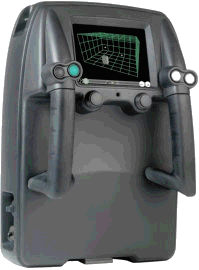 Cambridge UK,
Cambridge UK,
– Cambridge Consultants launches prism 200, a compact ‚through-wall‘
radar sensing device which gives security forces a means of reducing
the enormous risks involved in tactical entry, and siege or hostage
situations.
The
product, which is the size of a briefcase and can be carried and used
with one hand, employs sophisticated software to evaluate the position
and movement of people in rooms and buildings. The product is highly
valuable in a number of situations where it would be otherwise
impossible to gain such intelligence. Capable of working to distances
of up to 20 metres, it provides users such as police and special forces
with answers to two key questions which guide their choice of tactics:
"Is anyone behind this wall?", and, "What is the pattern of activity
inside this building?"
prism
200 incorporates three advances that make through-wall radar technology
a highly practical proposition for security personnel: a radar device
that is battery-powered and highly portable; smart radar signal
processing that senses human movement and position – even in difficult
environments with lots of reflecting surfaces; and meaningful data
presentation in forms to suit the user, including plan, elevation or 3D
views.
This
product launch follows the production of a prototype in 2005, which
Cambridge Consultants has demonstrated in countries around the world.
The feedback gained from police, special forces and emergency service
personnel has helped the company develop and package the technology to
suit potential users, and numerous advance orders for prism 200 have
already been placed
"To
commercialise this technology, we’ve talked to the spectrum of
potential users and spent over a year refining the hardware and
creating a man-machine interface that provides critical intelligence in
an intuitive form", says Alan Wiltshire, Product Manager. "The result
is a ’switch on and go‘ unit that can instantly deliver high-level
location information that helps tip the balance in favour of security
operatives in a broad range of dangerous or time-critical situations."
prism
200 will monitor several subjects and track movement, even in difficult
environments such as offices, with their angular surfaces and metal
objects which can act like a ‚hall of mirrors‘ to a normal radar.
Cambridge Consultants‘ advanced signal processing software is designed
to distinguish moving people from these reflections, distilling vital
information that can help observers to determine the real situation
inside a building, and what is the best position and time for a
tactical entry.
The
position of each subject is clearly indicated on the screen, and people
can be tracked as they move, to build information on behaviour and room
layout. Users can choose to see this information in plan, side
elevation or 3-dimensional views, or all three simultaneously. When
using the 3D view, the user’s viewpoint can also be rotated. This
feature could be used to understand clearly where a subject would be,
or appear from, as forces enter the space from a particular point.
Such
intelligence can help security personnel dealing with extremely
dangerous people and situations, such as terrorists and hostage taking.
In the case of a siege, the radar allows an observer to build a picture
of location and movement patterns inside a building. For this
application, multiple prism 200s can be linked by an Ethernet network,
if required, with information transmitted to a remote PC.
The
radar antennas inside are arranged in such a way that prism 200 has an
extremely wide field of view: 120 degrees horizontally and 90 degrees
vertically. When combined with the range of the radar, which may be
user-selected in four steps up to 20
meters, this provides comprehensive coverage of interior spaces.
During
operation, context-sensitive icons are displayed underneath the radar
screen, to provide the operator with a one-touch means of changing key
parameters such as the type of view, or range.
prism
200 can be held against a wall or mounted on a tripod in a ’stand off‘
position. The radar uses ultra-wide band (UWB) radar pulses that pass
easily through standard building materials including bricks, blocks,
concrete, timber, plaster, tiles etc. The radiated power is very low
and the unit is inherently safe to use.
The
ergonomics of the finished radar unit has been a key focus of the
development process. The packaged system measures just 210 x 300 x 450
mm and weighs 5.4 kg, w
Source: http://www.sensorsportal.com/HTML/DIGEST/december_06/Radar_sensing_device.htm
